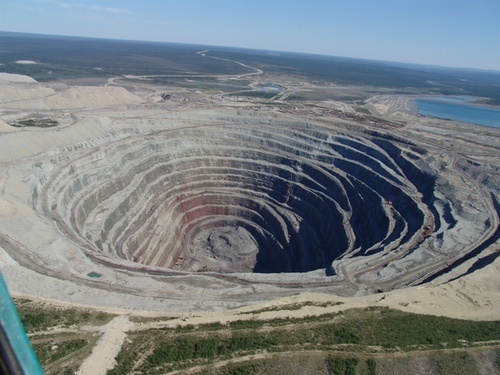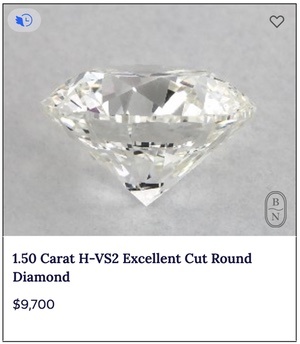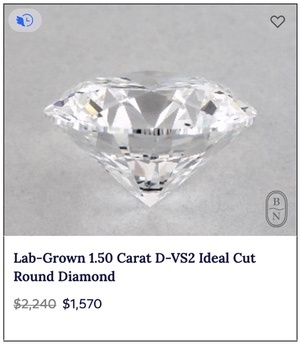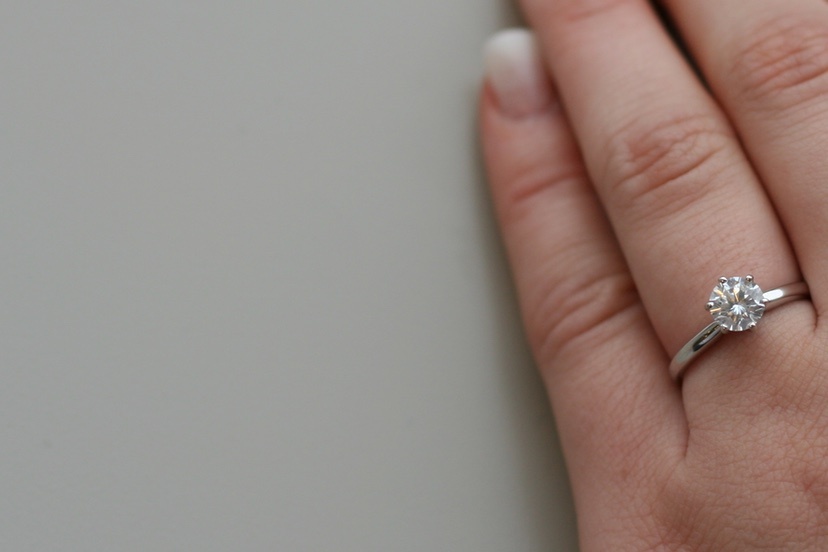Get Easy Financing, Free Shipping, Low Price Guaranteed. Save up to 70% vs Retail on your Lab Diamond. Speak with a Diamond Expert and save today…
— the the Brilliance.com website
When Darlene and I got married, no diamonds were involved. We slipped plain, unadorned gold bands onto each other’s fingers.
We could have claimed that we were protesting the cruel and violent history of Africa’s diamond industry. But the fact of the matter was, I was simply too cheap to spring for a diamond ring.
This wouldn’t necessarily be the case, if Darlene and I were getting married in 2024. Diamonds are on sale lately, thanks to the new technology for “growing” diamonds in an industrial factory. While it takes Mother Nature millions of years to grow the old fashioned kind of diamonds, a modern synthetic diamond can be grown in less than a week. About the same amount of time it takes to grow alfalfa sprouts.
So that part of a marriage is getting easier.
They are never called “synthetic” diamonds, however. Or “factory” diamonds. They are called “lab diamonds.” Like something from a scientific laboratory.
“Synthetic” would make them seem somehow artificial. Which of course they are. And “factory grown” obviously has unsatisfying connotations. You’re going to make your bride wear something from a factory? Good luck with that one.
But if it ‘s something that came from a real, honest-to-goodness scientific laboratory — and if it’s not a “gain-of-function” virus — that’s quite acceptable at the altar, nowadays.
With “lab grown diamonds” you don’t end up with a big hole in the ground. Or mining accidents. Or polluted groundwater. Or a maxed-out credit card.

As it turns out, diamonds are fairly easy to make, in a “laboratory”.
Basically, you start with a tiny piece of a diamond in a growth chamber — the “seed crystal”. You fill the chamber with methane gas — the same gas that feedlot cows are famous for burping — heat the chamber to about 1200 degrees, blast the methane with a microwave beam (sort of like a laser beam), and a few days later, Meghan Markle is walking down the street with new earrings.

Meghan also has a diamond ring, but even that didn’t guarantee an invitation to King Charles’ coronation.
Reportedly, younger people (and I would consider Princess Meghan a younger person) are embracing lab diamonds because they’re more environmentally sustainable.
But wedding rings and jewelry constitute just a tiny sliver of the diamond trade. Diamonds are harder than almost anything, and the vast majority of diamonds are “industrial diamonds” used for drilling, grinding, and polishing. (You could use a wedding ring for these purposes as well, but most people don’t.)
This quality of hardness means that a diamond will last practically forever.
Unlike most marriages.
Learning all this stuff, I got curious about pricing. I mean, what does it mean when a diamond has a “Low Price Guarantee”? I mean, I understand “Easy Financing” and “Free Shipping”. But what, exactly, is a “Low Price”?
I visited the advertised retailer displayed at the top of my search page — Blue Nile — and found a 1.5 carat ‘natural’ diamond priced at $9,700.
And a 1.5 carat ‘lab grown’ diamond for $1,570. (Marked down from $2,240.)
I couldn’t see much difference. Maybe the ‘natural’ diamond had a slightly yellowish cast? I doubt Darlene would have noticed.


But that’s all water under the bridge. I don’t even know what happened to our wedding rings after the divorce.
Anyway, the Blue Nile website said they had over 32,000 lab grown diamonds in stock. I assume most of them are much smaller than 1.5 carat, because the young Gen Z kids who are now thinking about getting married — and really, not that many of them are thinking about marriage — they tend to have a lot of student debt.
You can get a plain gold band for $105 at Walmart.
On a related note, some scientists in Beijing, China, have proposed that — based on surveys of the planet Mercury — it appears that the planet is made of mostly carbon, which could be graphite (like your pencil lead) or diamonds (like the gem you didn’t buy for your bride.) From an article by journalist Shubhangi Dua, posted on Friday on Interesting Engineering.
In a new study, scientists have proposed that Mercury houses a nine-mile-thick layer of diamond, which is probably situated at the core-mantle boundary. This finding challenges earlier assumptions that only graphite exists within Mercury’s interior…
This discovery was made possible through a simulation model, where experts utilized high-pressure and high-temperature experiments to replicate the conditions of Mercury’s core-mantle boundary…
So maybe diamonds are not only “forever” but also “plentiful”. In certain places.
Underrated writer Louis Cannon grew up in the vast American West, although his ex-wife, given the slightest opportunity, will deny that he ever grew up at all. You can read more stories on his Substack account.

